 loading
loading
featuresThe pizza crawlWe sent two eminent foodies to scope out five storied New Haven pizzerias. Who's got the best pies? Read on. Corby Kummer ’78 is Executive Director of the Food and Society policy program at the Aspen Institute, senior lecturer at the Tufts Friedman School of Nutrition, and a senior editor at The Atlantic. He has won six James Beard Journalism Awards, and the San Francisco Examiner has called him “a dean among food writers in America.”  Mark OstowView full imageI was sure that in the few years (okay, few decades) since I frequented Wooster Square as an undergrad, the staffs, ownership, and crews of all New Haven’s apizza shrines—which still draw food tourists from around the nation and rank highly, sometimes highest, on best-pizza lists—would have changed. My tastes too. After all, when I was in college, what did I know of Campo de Fiori in Rome, let alone Da Michele or the many self-proclaimed best pizza parlors in Naples? Niente. Perhaps unconsciously inspired by the endless waits and discussions and anticipation of my undergraduate pilgrimages to Wooster Street, I did spend much of the next few years, I mean decades, after graduation visiting all those pizza ovens and more. I spent days apprenticing with master pizza bakers in Italy, including up-to-the-minute ones like the Roman outposts Katie Parla ’02 extols in her city guides and apps. I wrote a chapter on Boston’s pizza for Pizza: A Slice of Heaven, a masterly pizzeria anthology by Ed Levine, founder and overlord of the website Serious Eats. Recently, the Yale Alumni Magazine wrote me with an offer I couldn’t refuse: an updated New Haven pizza crawl, with unlimited license to critique. I would visit, incognito, all four of the pizzerias most popular among today’s Yale students: Sally’s, Pepe’s, Modern, and the newcomer, BAR. Ed Levine was my mandatory top choice as fellow eater—and very luckily, he made himself available. We added Zuppardi’s, not a frequent Yale haunt but one Ed, along with my New Haven informants, declared essential. So what did I find? My taste had not shifted by one Wooster Street storefront since I was an undergraduate. 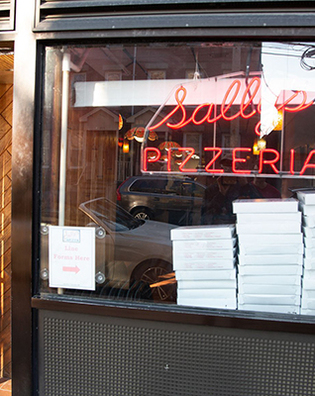 Mark OstowA display of pizza boxes in the front window greets visitors to Sally’s Apizza, one of the two famous Wooster Street pizzerias. View full image
Sally’s Sally’s still rules Wooster Square. Anyone who prefers Pepe’s is, well, somebody who likes something famous because it’s famous. Why Sally’s? First, there’s that great grime. Or maybe not grime exactly, but flyspecked posters and press clippings on the rec-room walls, and phony-faux-plastic-glass olde-timey tulip chandeliers that don’t seem to have changed since I last visited, which is saying something. There’s the jaunty Garry Trudeau poster for Sally’s 50-year anniversary that Ed Levine managed to secure rights to for the frontispiece of his pizza guidebook—as he proudly pointed out to Dan Cahill. Cahill is the head of special projects and brand management for Lineage Hospitality, which at the end of 2017 bought Sally’s from the Consiglio family, which had opened Sally’s in 1938 and operated it continuously. The servers at Sally’s are curt and borderline surly if you don’t know them, and not much better if you do. Don’t make the mistake of thinking the friendly guy who seats you almost immediately if you get there early for lunch (a post-sale innovation) and smiles as you say just what pizza you’d like will actually transmit your order. That’s for the server to do, and he’ll get to you when he’s good and ready. But the server knows exactly what he’s doing, and so does every person who’s worked in the kitchen for the past 15 years. If not a model of warmth, Sally’s is a model of professionalism. What’s superior about the pizza? Pretty much everything. The crust is blackened on the bottom, blackened at the edges (which are minimal), and covered with a fine black powder we could only decide was coal dust from the not-so-well-swept floor and ceiling of the coal-fired oven. The tomato sauce for the tomato pie, a secret blend of canned tomatoes (no sin! It’s what they prefer in Italy), is vibrant, fresh-tasting, not too liquidy and not too tomato-pastey. That’s all that tops the tomato pie, along with a few speckles of grated Romano and that fine black dust. It is, not to use too fine a word, a masterpiece. The crust is firm and crackling but not lavash-thin, as too much new-wave pizza mistakenly is; it’s still pliable, but not wet, underbaked, and doughy, as frankly most vera pizza Napoletana is. (You can now find an example across the street at the new Zeneli.) The sausage and mushroom pizza Levine makes me order as a second benchmark is fine, too, the cheese sparing, the sausage richly flavored without being bitingly salty and bitingly tough, the way most pepperoni is. We stack pizzas in boxes to take away and head to the line-out-the-door lunch crowd at Pepe’s. If only they knew what they were missing. ALUMNI SAY: 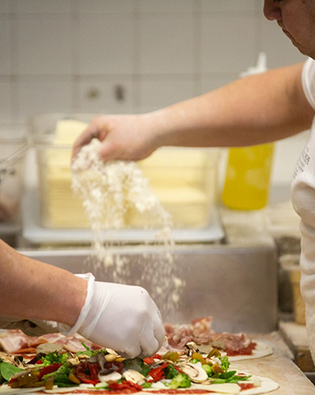 Mark OstowThey’ve been making pizza by hand at Frank Pepe’s for 95 years—longer than anywhere in New Haven. Now Pepe’s has 11 locations in the northeast. View full image
Pepe's The lines are still long. They always were—a big, big disincentive to going there, particularly if you’d walked from campus and arrived hungry, as of course you did. The difference: then, you got pies made by members of the original family, or not too far removed from the descendants of Frank Pepe, who started selling pizza in New Haven in 1925. Today, you get second- and third-hand training from the descendants of the nine relatives who inherited Pepe’s. “Talk about a recipe for dysfunction!” says Levine, who has studied the histories of most of the Northeast’s historic pizzerias. Sal Consiglio, the founder of Sally’s, was Pepe’s nephew, and he managed to restrict the in-the-hands knowledge of baking his pies to just three people—as Levine tells me and our Sally’s veteran server confirms. That helps explain why Sally’s pizza has stayed so good, even if the current owners are presumably less fanatical about safeguarding the recipe and technique, since they’re adding locations one by one. Pepe’s has been more profligate: its branches now number ten, all in Connecticut and surrounding states. Some are excellent, and local lifesavers. As someone who grew up two towns from Manchester, Connecticut, I’m grateful there’s a Pepe’s near my home town. A friend says she ate one of the best pizzas of her life at the Pepe’s in Waterbury. Levine tells me that when David Simon, creator of The Wire, filmed a subsequent series near Westchester, he was saved by the Yonkers location of Pepe’s. But the quality varies. Disastrously so, at the Wooster Square original—at least when Levine and I met friends there post-Sally’s. First, the place was too darn clean. The dark hospital-green walls were no more attractive than they ever were, just freshly painted; the faux milk-glass 1930s lamps were actual glass, okay, but awkward reproductions; the bright red neon “tomato pie” sign—everything seemed self-consciously cute, the way tourist destinations often get. The real problem was the pizza. The crust was tough and salty, the flavor undeveloped; overnight cold dough rises are part of what made New Haven stand out, but they apparently got skipped. And the famous clam pizza—the reason for waiting, the pizza that launched a town’s legend, the juicy, freshly shucked clams with chopped garlic, some sprinkles of pungent Romano, and then bliss—arrived barely warm, the clams rubber, the garlic burnt. Burnt garlic, in fact, was the only flavor that registered and, unfortunately, lingered. While we’d been waiting in line outside, our friends had opened the three Sally’s pizza boxes we’d awkwardly carried from down the street. One rolled up a slice and ate it then and there. Then he went in for a second slice from another box, boldly taking the risk of spoiling his appetite. One of his companions decorously held her slice flat, eating slowly to save her appetite for the pizza inside. A reasonable choice. As it turned out, the wrong one. ALUMNI SAY: 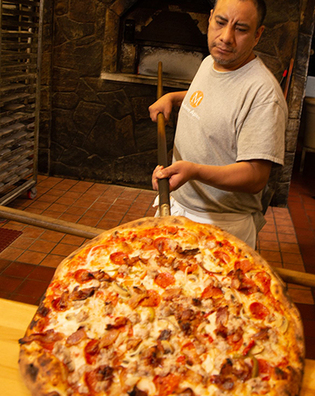 Mark OstowGeorge Quinde serves up an Italian Bomb—which features bacon, sausage, and pepperoni—at Modern Apizza on State Street. View full imageModern Apizza “Yeah, I’m going to Seattle Friday,” the youngish non-student at the huge pass-through to the pizza oven said to the waitress at the cash register. “Hitching.” They caught up some before he paid his green paper check. It looked like they’d known each other a long time. The Naugahyde booths were filled with Yale professors, workers from local businesses, and families, and the servers seemed to have known a good many of them a long time, too. Modern Apizza has a family feel, fully integrated into its East Rock neighborhood, much closer in to Science Hill and downtown and residential areas than Wooster Square. Everything about it feels familiar, comfortable. The slightly gruff welcome is the same for everyone, and very familiar from my northern Connecticut upbringing. The booths, the posted menus, the solid tables and chairs—all are clean, in good shape, and, like the cashier’s conversation, unselfconscious. Lines? Don’t worry. You come in and find a booth or table in one of the two capacious rooms, you place your order, you get comfortable. No mystique. It’s a very different feel from Wooster Square. The pizza is comforting, too—maybe a little too comforting. The crust is more substantial than Sally’s or Pepe’s, dusted with a special bread crumb mixture rather than cornmeal, disappointingly blond rather than blistered by the oil-fired oven. (Great pizzas do emerge from both oil-fired ovens and wood-fired ovens, so I won’t bash non-coal even if I’m a member of the coal cult. It’s the temperature of the oven, the flavor development of the dough, and the quality of the toppings that matter.) The crust, as it happens, needs to be sturdy. Every pie starts with what Levine calls “space blanket cheese”—a carpet that in texture and dulled sheen is a bit too reminiscent of the Naugahyde booths, its flavor not far from the American cheese Modern also offers. Margheritas, a Modern specialty, are made with local mozzarella, but the space blanket tastes generic—good for the children in the families Modern caters to, maybe, but too Chicagoan for someone who likes svelter, New Haven–style pizzas. The spinach on a vegetarian pizza is waterlogged, the sausage and mushroom plentiful but unremarkable. But this is a place of abundance: its signature pizza is the Italian Bomb, and there’s even a Veggie Bomb. To complain—about the slightly underdone, slightly thick crust, the heavy layers of toppings that make this more a pan pizza than something close to Neapolitan, the unmemorable but perfectly serviceable ingredients—is to carp. Modern (and also Zuppardi’s) offers the quintessential New Haven pizza experience. Its roots are in the Italian-American community where Tony Tolli, born in Plainfield, was raised and opened the precursor to Modern in 1934. A latter-generation local, William Pustari, loved Modern and bought it in 1988, changing it only slightly and knitting it even more firmly into the community. Its service makes families view it as an extension of dinner at home. It’s local, that is, in the best way a restaurant can be. ALUMNI SAY: 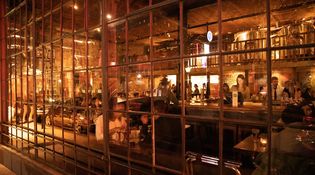 Mark OstowWith house-brewed beers, a dance floor, and a location amid New Haven’s club scene, BAR doesn’t fit the mold for New Haven pizzerias. But their pizza has won wide acclaim. View full imageBar I hate myself for thinking the overall best pizza in New Haven is at a place that didn’t even exist when I graduated. Bar started in 1991 as a dance club and bar, and in 1995 began brewing its own beers and, importantly, making pizza. Twenty-five is, of course, older than a college grad, but barely better than a toddler in terms of New Haven pizza. BAR has exposed brick, dark wood beams, a double-high ceiling, and too many trappings of a hipster brewpub to seem trustworthy for a pizzeria. Particularly a New Haven pizzeria. At first look, it appears to be a generic college (or grad-student, 21 being the required age) hangout in a college town, the sort built by out-of-towners who did a little market research and copied two dozen other places. The owners are, though, Connecticut boys. Frank Patrick majored in animal science at UConn and worked his way up from bartending in the early days. Randy Hoder’s mother introduced the house salad—which unlike that of any other pizza place has acquired a reputation of its own—with pecans, blue cheese, pears, and a raspberry vinaigrette. And two brothers, Leo and Gustavo Rojas, have been wielding the pizza peels for nearly 20 years. So BAR isn’t corporate. It has found a place in New Haven hearts, perhaps not as exalted as that of Louis’ Lunch—smack across the street and so visible through the glass firehouse-sized windows that it’s practically part of the décor (“the most overrated burger in America,” Levine muttered as we sat down)—but a place high on any pizzeria list and with more stuff you want to eat. The clam pie shouldn’t be second only to Zuppardi’s—BAR is a youngster!—but it is, with plump clams spaced at just the right distance and subtle fresh garlic sparingly and accurately dispersed. The crust is rivaled only by Sally’s for both flexibility and flavor, particularly surprising since crusts of BAR’s thinness usually turn pizza into big crackers. It makes every pizza here superior: the underside of the crust has just the right number of black freckles. But it’s the clams that lift the clam pie to the stratosphere. Shucking to order is always key, but here the clams have actual flavor and briny moistness, in contrast to BAR’s more famous rivals whose pre-shucked clams are little rubber tips. The pièce de résistance is mashed potato pizza, which sounds ridiculous (and is; Hoder modeled it on the spaghetti-on-white-bread sandwiches of his youth) but makes sense when you remember you’re in a bar, where people look to fatty bland food to absorb the accumulating effects of many brewed-on-site beers. What sounds gloppy, stodgy, and awful turns out to be terrific: a thin layer of slightly chunky, freshly made mashed potatoes on the crust that’s actually much less rich than the Modern space blanket of cheese and with more texture. Bits of bacon add chew and savor that curiously lighten what should be a frankly gross experience. “This is perfect junk food,” Levine remarks. “I bet they sell a lot as the night goes on.” Me too. But I’d gladly order it for lunch and bet I’d get through the afternoon energized. ALUMNI SAY: 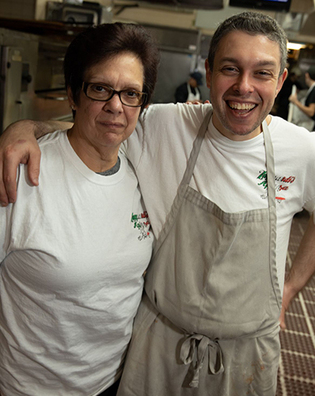 Mark OstowJust a ten-minute drive from campus, Zuppardi’s is little known on campus. But the family—including co-owner Cheryl Zuppardi Pearce and her son John Craig Pearce Jr. —has been making pizza in West Haven since 1934. View full imageZuppardi's To step into Zuppardi’s Apizza, in West Haven, is to step into a time warp, complete with flour-dusted shelves by the main door. Those shelves hold books that mention Zuppardi’s pizza, including Ed Levine’s own A Slice of Heaven—so we liked the place right away. Plus, I love entering aluminum-sided time warps with active kitchen scenes, scenes that appear to greet you as you place your order: the tiled kitchen and brick oven take up half the restaurant. As at Modern, everybody, staff or customer, seems to know each other. Because of its location, Zuppardi’s is not much frequented by Yalies—probably not frequented at all by the vast majority of Yalies—and we’ve traveled to this West Haven outpost only because Levine fervently believes it is the right thing to do. Zuppardi’s is known for the best clam pie, he says. And it wins. The fresh-shucked clams are the plumpest and moistest of any we’ve tasted. The mushroom-sausage pizza has by far the most flavorful, least processed-tasting sausage meat, in appealing chunks rather than suspiciously uniform slices. Yes, there’s too much cheese on the mushroom-sausage, and a funny iridescent goo lining the clam pie that makes it look like it’s about to get a sonogram. But neither spoils the flavor, and though the crust could have more-developed flavor, it strikes the right balance between moderate thinness and resilience to support the toppings. Zuppardi’s wins, too, for retro design: big red pizza trucks pictured at every table (with “Est. 1934” visible on every truck) and, most important, pizza boxes with red script straight out of the late Fifties. Whenever these were designed and wherever they were made, every other New Haven pizzeria needs to step up its pizza-box game. All the other boxes were plain white. Any red came from the tomato sauce that inevitably spills onto your hands, coat, and box as you hand-transfer the leftover slices—which is of course a process integral to the New Haven experience. Yale students may never swarm to Zuppardi’s, which is a three-mile walk from Woolsey Hall. But anybody with a car or enough money in an Uber account won’t mind. They’ll have their clam pizza with no overcrowding, long lines, or curt servers, in a place that could hardly be friendlier. ALUMNI SAY:
|
|
3 comments
-

Peter Richmond, 11:27am March 02 2020 |  Flag as inappropriate
Flag as inappropriate
-

Jim DeAngelis, 12:47am March 05 2020 |  Flag as inappropriate
Flag as inappropriate
-

Lisa Farley, 1:34pm March 22 2020 |  Flag as inappropriate
Flag as inappropriate
The comment period has expired.There's no point in reading anything else today. The craft in this piece of food scribing is as delicate and satisfying as the fare he describes. (As soon as I finish this post, I'm heading to New Haven; 90 minutes is nothing when Hummer and Levine's treasures await). On a person note, one of the great tragedies in my life occurred one night in my first week at The Register on the sports copy desk, six months after graduating -- a job!. My eight o'clock break was an hour, and I figured, with luck, I could get to Sally's, gather my meal and get back to my desk without being late. Of course, I'd cut it as think as Sally's crust, and, racing back in my battered '70 Valiant to Orange Street, driving with a leaden foot, I hit the brakes too hard at a stop sign and the box holding my precious pie slid to the floor, flipping onto its side, then turning over. I may have been weeping as I reached down to see that the pie had, of course reconfigured itself into something like a casserole. Of course, it still tasted insanely great. I wonder how many of us, having gone through our college acquiring thousands of indelible memories, still rank Wooster Street in the top five?
Growing up in New Haven and studying as an undergrad and graduate student at Yale there were many nights to go to Sally's which for my family was the only pizza parlor at which to eat because, aside from the thin crest and great toppings, my father's photo was prominently displayed not too far from Sinatra's. My dad died in 2007 at the age of 97; his wake was just around the corner from Sally's.... of course, we made the pilgrimage...
A few years after that I was back in New Haven and stopped in for a pie. Flo, Sal's widow, was there behind the counter, as usual, and asked me a very specific question.... "where's that red bandana?" I couldn't believe that she remembered that, back in the day, I always had one hanging out of my back pocket... of course, I had to explain that to my wife and daughter who knew almost nothing about Sally's or my life in New Haven.
I've sent the article to some classmates as well as my New Haven friends for their comments. If any of them are of interest, I may post them here.
It's very hard to imagine Sally's as non-family owned and without Sal & Flo. Frankly, I'm not inclined to make the trip to New Haven for Sally's now, but part of the reason is that I've found a very small pizza place in a French village (Paulhan) where we have a secondary residence, Phillips Pizza, that is family owned and started, not in a shop, but in a van parked evenings in a nearby grocery store's parking lot... Phillip makes very thin crusts that are favorably comparable to Sal's. Check out my Trip Advisor review.
For those of us who were at Yale in the early 90s I would argue Demery's was hands down the favorite slice. After a long week of studying, a late night dancing to songs like "Oh, What a Night," there was nothing like a $2 slice on the way out. I am saddened for current Bulldogs who only have an Au Bon Pain on that epic corner of Broadway and York.